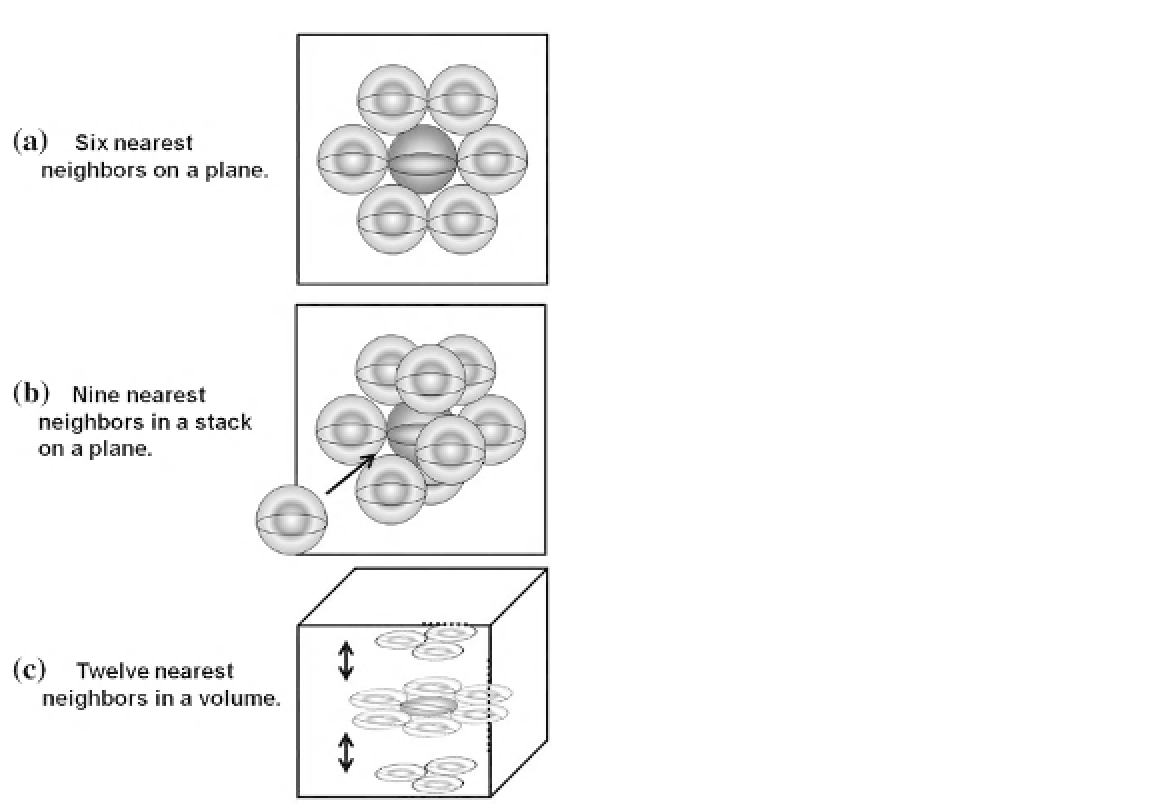Biomedical Engineering Reference
In-Depth Information
layer of ball bearings in contact with the surface
atoms comprising the six close-packed planar
arrangements (
Figure 8.2
b). Inspection reveals
that the central ball bearing in
Figure 8.2
b would
have three additional ball bearings lying in the
interstices between contacting neighbors in the
plane.
Thus, the central surface atom has six nearest
neighbors in the plane and three additional
nearest neighbors in a contacting second layer,
or a total of nine nearest neighbors (
Figure 8.2
b).
The bulk phase can be modeled by placing a
central ball bearing between two such layers of
contacting ball bearings (
Figure 8.2
c). Inspection
of this arrangement reveals that the central ball
bearing and its neighbors within the plane are
sandwiched between three upper and three
lower neighbors, yielding a total of 12 nearest
neighbors (three on the bottom, three on the top,
and six in the plane). So then, in summary, a
surface ball bearing has nine nearest-neighbor
interactions, whereas a bulk-phase ball bearing
enjoys 12 nearest-neighbor interactions. The sur-
face ball bearing is thus bound by 9/12
=
3/4 of
the energy of a bulk ball bearing. In other words,
the surface ball bearing has 1/4
=
25% excess
energy compared to a ball bearing in the bulk
phase
[14]
.
Although this ball-bearing model has a very
limited range of applicability to real-world
materials, it does give a sense of scale of surface
energetics. Surface energy is about 25% of the
cohesive energy of materials that must be over-
come to create a surface. Thus, most or all of the
energy required to cleave a material ends up as
surface energy. It definitely takes work to create
a surface. Surface energy falls within a broad
range depending on material characteristics,
between approximately 10-1,000 mJ/m
2
. When
surfaces are a large fraction of the system (large
surface area, as occurs with particles or thin
films) or when surface reactions are important,
as in biomaterials, then surface energetics are
necessary to take into careful consideration
(
Box 8.4
).
FIGURE 8.2
Nearest-neighbor interactions among spher-
ical atoms comprising a hypothetical material.
Figure 8.2
a
shows that, on a planar surface, a central atom (darker color)
can be surrounded by 6 nearest neighbors (lighter color) in a
close-packed arrangement. An adjacent layer brings 3 addi-
tional nearest neighbors into contact with the central atom
(
Figure 8.2
b, arrow points to the location of a third atom
displaced to reveal the central atom).
Figure 8.2
c illustrates
the packing arrangement relative to the central atom
immersed in the bulk of the hypothetical material. Account-
ing leads to the conclusion that a surface atom (
Figure 8.2
b)
interacts with 9 nearest neighbors, whereas a bulk atom inter-
acts with 12 nearest neighbors, causing the surface atom to
be deprived of energy-stabilizing interactions. This leads to
excess energy at the surface and is the origin of surface
energy.
atoms of the second layer of the material, which
would be in contact with the third layer and so
forth, propagating further into the
bulk phase
.
This effect can be modeled by adding a second

